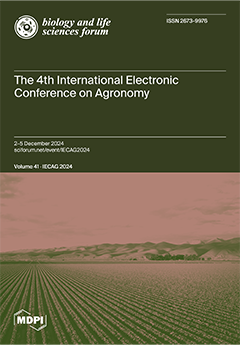Oat (
Avena sativa L.) is one of the most important self-fertilizing field plants belonging to the Poaceae family. It has no significant requirements regarding growing conditions but has a very good reaction to fertilization. The current research evaluated the significance of the effects of individual applications of mineral (NPK) and organo-mineral (OMF) fertilizers, as well as their individual combination with slaked lime (calcium hydroxide, Ca(OH)
2), on the yield, morphological traits [mean number of leaves per plant—MNLP, minimum leaf length (cm) per plant—MinLL, maximum leaf length (cm) per plant—MaxLL, number of ears per plant—NEP], and physiological parameters (nitrogen balance index—NBI, content of chlorophyll—Chl, flavonoids—Flv, anthocyanins—Ant) of organic and pelleted (graded) oat plants, comparing the treatments and in relation to the control. The experiment was performed in semi-controlled glasshouse conditions, in pots, from the fourth week of March to the fourth week of June 2024, using Vertisol soil. This soil is characterized as light clay with an acid reaction. Physiological parameters were measured using a Dualex leaf clip sensor. The results obtained showed that physiological parameters in both oat types significantly differed (
p < 0.05) between the treatments applied and in relation to the control, whereas the morphological traits did not significantly differ (
p > 0.05) between the treatments. Statistically significant differences (
p < 0.05) in the yield of both oat types were most pronounced in the OMF + Slaked Lime treatment (organic: 4.49 g pot
−1; pelleted: 4.61 g pot
−1) in relation to the control (organic: 2.48 g pot
−1; pelleted: 2.63 g pot
−1). The pelleted oats showed slightly better results for the effects of different treatments across all tested parameters compared to organic oats. In conclusion, the best results were obtained with the use of OMF + Slaked Lime, which could be proposed as the optimal fertilization treatment for pelleted and organic oat cultivation based on this research.
Full article



